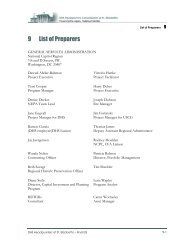395 - GSA Development of St. Elizabeths Campus
395 - GSA Development of St. Elizabeths Campus
395 - GSA Development of St. Elizabeths Campus
- No tags were found...
Create successful ePaper yourself
Turn your PDF publications into a flip-book with our unique Google optimized e-Paper software.
Headquarters to <strong>St</strong>. <strong>Elizabeths</strong> and any associated transportation improvements do not occur.However, DDOT transportation improvement projects will still be constructed under the No-Build Alternative, along with other planned land developments, and the shifts in backgroundtraffic patterns that are projected to occur within the study time frame are accounted for.Proposed or ongoing projects that are currently expected to produce significant effects on theexisting transportation network include the following: the 11 th <strong>St</strong>reet Bridges replacement,South Capitol <strong>St</strong>reet corridor improvements, redevelopment <strong>of</strong> the south parcel <strong>of</strong> the East<strong>Campus</strong> by the Deputy Mayor’s Office for Planning and Economic <strong>Development</strong> (DMPED),Poplar Point development, and Barry Farms development. In addition, the projectedemployment growth at Anacostia Naval <strong>St</strong>ation/Bolling Air Force Base will requiretransportation improvements.2.4.1.1 FreewayWith a few exceptions, freeway conditions along I-295 and South Capitol <strong>St</strong>reet for the No-Buildcondition are similar to those <strong>of</strong> the existing conditions described above, with several locationsalong both corridors experiencing increased delays and travel times. Locations for which theNo-Build conditions (2020 and 2035 time horizons) are different from the existing conditions aresummarized as follows:• I-295 – Missing movements at the 11 th <strong>St</strong>reet Bridges are completed, resulting in lessqueuing at some interchange ramp terminals that currently serve cut-through traffic onthe local roadway network• Suitland Parkway – The new diamond interchange configuration <strong>of</strong> I-295, withconsolidated on- and <strong>of</strong>f-ramps at Suitland Parkway, shows increased queuing on theramps that reflects back on I-295 as well as queuing on the crossroad that spills back onSuitland Parkway from the signalized ramp terminals• South Capitol <strong>St</strong>reet – The existing system <strong>of</strong> freeway ramps that connect South Capitol<strong>St</strong>reet and Suitland Parkway at the foot <strong>of</strong> the Frederick Douglass Bridge is replacedwith an at-grade traffic circle. As a result, traffic queues within the circle and on theapproaches. Operations <strong>of</strong> the traffic circle are largely influenced by upstream anddownstream intersections, especially at South Capitol <strong>St</strong>reet/Firth <strong>St</strong>erling Avenue andat Suitland Parkway / Southbound I-295 interchange ramps2.4.1.2 Local <strong>St</strong>reet NetworkThe local street network reflects a complex operational condition that results in some networkimprovements but also degrades in several areas due to changes in roadway configurations andadjacent land development projects. Highlights <strong>of</strong> local street operations are characterized bythe following:• Suitland Parkway at Firth <strong>St</strong>erling Avenue – This intersection represents one <strong>of</strong> the key“hotspots” within the network in terms <strong>of</strong> magnitude <strong>of</strong> congestion. Queuing occurs onall approaches in accordance with peak period travel patterns and increases due totransit and pedestrian modal conflicts. A new <strong>St</strong>reetcar operation included in the No-Build scenario contributes to queuing because it requires additional time in the trafficsignal cycle (i.e., reduces the total amount <strong>of</strong> green light time available to vehicles at thisintersection) to ensure its path does not conflict with permitted vehicle turningmovements. Pedestrian crossing phases contribute to queuing because they must2-8
















